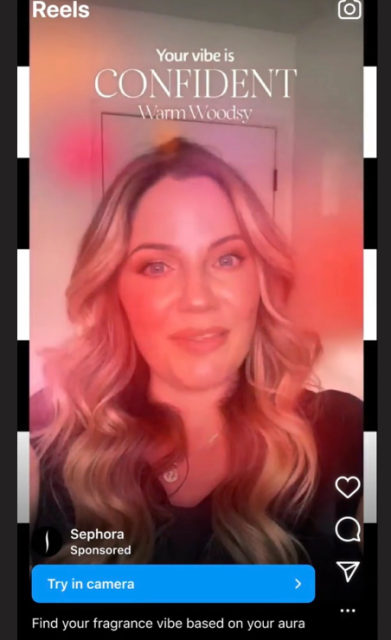Meta is Pitching its Reels AR Ad Campaign Tools to Advertisers
During IAB’s NewFronts, Meta announced that Augmented Reality would soon be coming to Facebook Stories and Reel Ads. The announcement was made as part of the company’s pitch to advertisers.
Following the Augmented Reality update, brands such as Tiffany & Co and Sephora will be able to offer their users and customers more immersive experiences along with AR filters when they are marketing their products digitally to Meta’s audiences, particularly to the younger Gen Z users.
Meta said it will also be rolling out other enhancements and improvements to Reel Ads, noting that brands will now be able to also work with third-party measurement partners when running their Reel Ads campaigns.
Meta’s integration of Augmented Reality (AR) advertising could give the company an edge as it competes for marketing dollars with the likes of Snap which had long integrated AR filters as both social media giants target the younger Gen Z demographic.
Snap also unveiled its set of new ad products at the NewFronts last week. These include new Stories features as well as a TikTok clone called Spotlight. Snap also tested eye-catching sponsored links in its Artificial Intelligence (AI) chatbot feature, My AI.
Snap has been offering brands AR features and effects for quite some time now. The platform already includes various AR commerce features as well as its popular Snapchat Lenses. Through its AR Enterprise Services division, Snap is also working with brands looking to leverage augmented reality technology on their apps and websites.
Before making the announcement last week, Meta added AR ads in the Facebook Feed, Instagram Feed as well as in Instagram Stories. Based on its data, Meta says these ads contributed to incremental ad recall 87% of the time with the 18- to 24- year old users, thus outperforming the non-AR-enabled ads.
The AR ads will now run on Meta’s other prominent portals such as Facebook and Instagram Reels as well as in Facebook Stories.

Ahead of the launch, Meta’s new AR Reels ads were tested by Sephora in an ad where users pressed their thumb to the screen to create an “aura vibe” filter that assisted them in selecting the best-fitting fragrance and making a purchase. According to Sephora, more than half of the ad’s audience were Gen-Zers.
The Facebook AR ads feature was also tested by Tiffany & Co which created an ad that enables users to immerse themselves into the company’s flagship retail store located on 5th Avenue known as “The Landmark” and browse through its jewelry.
Apart from the news of its expansion of Augmented Reality advertising, Meta also announced new features that will make its Reel Ads more interactive such as a test of a larger “call to action” button that features extra advertiser information on Facebook and Instagram Reels ads. The button also features an ad thumbnail, headline, and other business details such as the website URL that encourages customers to click.

Meta is also allowing Facebook users to pause video ads and preview the landing page where the link will direct them to a feature that is likely to drive the click-through rates for Reels Ads.
For the shopping ads, Reels is adding new multi-destination product ads that will enable users to swipe through multiple product images in a carousel without the need to leave the Reel that they are currently watching. So users no longer have the ads only pointing to the website of the retailer or to a single product page.
Meta also revealed that marketers launching Reels Ads campaigns will be able to collaborate with select third-party measurement firms on the tool. Supported measurement services include MOAT, IAS, and Double Verify. Meta says these analytics firms are assisting it in testing out and launching a Reels Viewability reporting option which will later be rolled out to advertisers after the testing has been concluded.
During its presentation, Meta also pitched its investments in Artificial Intelligence (AI) and noted that it is already leveraging the technology in improving ads rankings by learning what ads work and which ones don’t. This will enable Meta to better predict the ads that will be most relevant to users.
Meta says AI is also “driving efficiency” for a suite of ad products by removing the many “manual and tedious steps” involved in the creation of an ad.
Meta says its investments in AI are already paying off, particularly in Meta Advantage, its brand name for its portfolio of Artificial Intelligence products.
Meta Advantage is leveraging machine learning and Artificial Intelligence to assist advertisers in testing and learning and to also assist them in fast-tracking their campaigns and acquiring and growing their customer base. Meta says most of its advertisers are already using the Artificial Intelligence product, Advantage+ Shopping which it launched last August.
Previously, advertisers had to manually set up their ad campaigns to test out the mix of targeting, creative, and placement which proved time-consuming for advertisers. Advertisers can now deploy Advantage+ Shopping campaigns that allow them to run millions of iterations that target performance scenarios in just milliseconds and allows marketers to choose the best combination so as to send out the best ad to the right person and at the right time. This is all enabled by Artificial Intelligence.
Meta says it is just starting out with the deployment of AI and users should expect additional product updates and announcements around its AI deployment in the coming weeks.
https://virtualrealitytimes.com/2023/05/04/meta-is-pitching-its-reels-ar-ad-campaign-tools-to-advertisers/https://virtualrealitytimes.com/wp-content/uploads/2023/05/Sephora-Reels-391x640.pnghttps://virtualrealitytimes.com/wp-content/uploads/2023/05/Sephora-Reels-150x90.pngBusinessDuring IAB’s NewFronts, Meta announced that Augmented Reality would soon be coming to Facebook Stories and Reel Ads. The announcement was made as part of the company’s pitch to advertisers. Following the Augmented Reality update, brands such as Tiffany & Co and Sephora will be able to offer their users...Rob GrantRob Grant[email protected]AuthorVirtual Reality Times - Metaverse & VR
